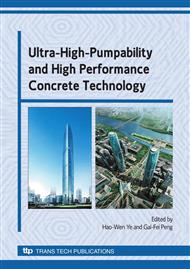p.183
p.186
p.191
p.197
p.204
p.212
p.219
p.226
p.234
C60 High Performance Concrete Prepared from Manufactured Sand with a High Content of Microfines
Abstract:
The workability, strength and modulus of elasticity, drying shrinkage and creep, and chloride ion permeability as well as freeze-thaw resistance of the C60 high Performance concretes (HPCs) with manufactured sand (MS) containing crushed limestone dust in percents ranging from 3.5% to 14% were experimentally investigated. The results were compared with those of river sand (RS) concrete. In addition, the effect of clay amounts at 3% and 5% in MS on properties of C60 HPCs was also investigated. The results showed that expect for the creep, the other performances of C60 MS-HPCs with crushed limestone dust content of 7% to 10.5% were excellent or compared favorably with those of C60 RS-HPCs. The increment of clay content in MS obviously decreased workability, increased dry shrinkage and accelerated freeze-thaw destruction of C60 MS-HPCs, but didn’t affecting compressive strength and chloride ion permeability of the concrete. It was concluded that C60 HPC can be made with MS with a high content of crushed limestone dust but the amount of clay in MS should be controlled to a low limit.
Info:
Periodical:
Pages:
204-211
Citation:
Online since:
January 2009
Authors:
Price:
Сopyright:
© 2009 Trans Tech Publications Ltd. All Rights Reserved
Share:
Citation:


